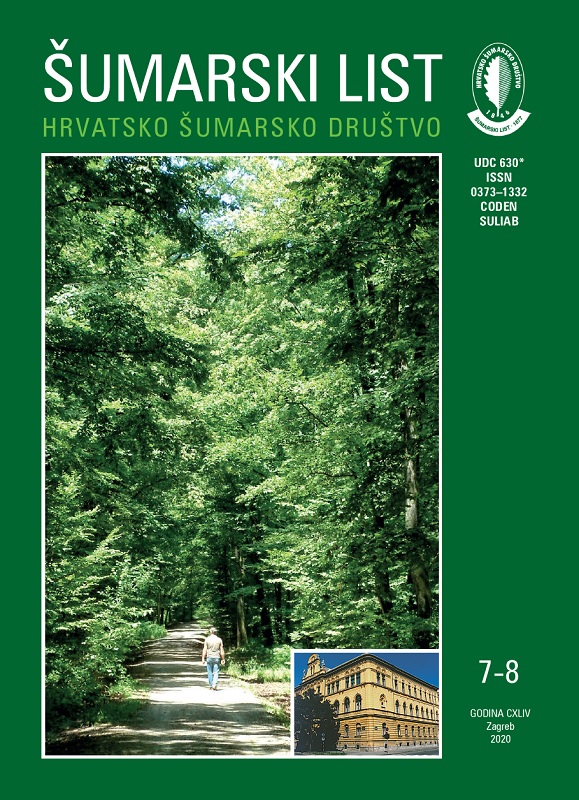
broj: 7-8/2020
pdf (6,01 MB) |
|
||||||||||||||
| RIJEČ UREDNIŠTVA | ||
| Uredništvo | ||
| Parafiscal levies – definition and who should pay them pdf HR EN | 337 | |
| IZVORNI ZNANSTVENI ČLANCI | ||
| Milan Pernek, Marta Kovač, Nikola Lacković | UDK 630* 453 (001) https://doi.org/10.31298/sl.144.7-8.1 | |
| Testing of biological effectiveness of pheromones and traps for catch of mediterranean bark beetle Orthotomicus erosus (Coleoptera, Curculionidae) pdf HR EN | 339 | |
| Mladen Ognjenović, Tom Levanič, Nenad Potočić, Damir Ugarković, Krunoslav Indir, Ivan Seletković | UDK 630* 425 + 111 (001) https://doi.org/10.31298/sl.144.7-8.2 | |
| Interrelations of various tree vitality indicators and their reaction to climatic conditions on a european beech (Fagus sylvatica L.) plot pdf HR EN | 351 | |
| Simon Lendvai, Jurij Diaci, Dušan Roženbergar | UDK 630* 242 (001) https://doi.org/10.31298/sl.144.7-8.3 | |
| Response of black alder (Alnus glutinosa (L.) Gaertn.) to selective thinning of various intensities: a half-century study in northeastern Slovenia pdf HR EN | 367 | |
| Besim Balić, Ante Seletković, Ahmet Lojo, Aida Ibrahimspahić, Jusuf Musić, Admir Avdagić, Velid Halilović | UDK 630* 516 (001) https://doi.org/10.31298/sl.144.7-8.4 | |
| Model for estimation merchantable wood volume of spruce (Picea abies Karst) in Canton 10, Federation of Bosnia and Herzegovina pdf HR EN | 379 | |
| Hüseyin Ogfuz Çoban, Halis Bereket | UDK 630* 432 (001 https://doi.org/10.31298/sl.144.7-8.5 | |
| Visibility analysis of fire lookout towers protecting the Mediterranean forest ecosystems in Turkey pdf HR EN | 393 | |
| PREGLEDNI ČLANCI | ||
| Željko Španjol, Boris Dorbić, Nikola Vrh, Ivana Gašparović, Ivan Tolić, Milan Vojinović | UDK 630* 187 + 174 https://doi.org/10.31298/sl.144.7-8.6 | |
| Vegetative and dendrological characteristics of Hober forest park in Korčula pdf HR EN | 409 | |
| Summary A systematic research of biological and ecological characteristics of the overall Hober area and Hober forest park itself has not been performed thus far. Structural characteristics of the stand were included only in The Management Plan for Hober Forest Park (2006-2015). Forestry issues were addressed in the paper by Vojinović (1997). Dendrological research was included in the papers by Denich and Draganović (1985), Vojinović (1997), Fabris (2001) and Onofri (2002). Its overall inventory records are missing. The current condition of Hober forest park is characterised by its neglect and no landscape design in terms of both forest vegetation, dendrological, horticultural and garden and architectural content. Moreover, there is conceptual indefiniteness of the overall Hober area. Hober forest park in terms of vegetation belongs to the forest community of the Aleppo pine and Holm oak (Querco ilicis – Pinetum halepensis Loisel 1971). It is primarily due to vegetative and structural unevenness that 7 experimental surfaces were placed in the forest park itself and 4 more outside of it. A comprehensive vegetation and structural analysis was intended for the selection of individual areas, in order to provide their description and present their condition, which can subsequently be used for the purpose of zoning the area. According to the analysed research the Aleppo pine prevails in the layer of trees on the surfaces 1, 2, 3 and 9; Holm oak on the surfaces 4 and 5 and Common cypress on the surfaces 6 and 7. Laurestine is the most common species in the shrub layer, which appears on all the surfaces. Then there are green olive trees with broad leaves and mastic trees. The tree layer prevails with the exception of the surfaces 8, 10 and 11 where there is maquis. It is evident that in developed stands the tree layer and the shrub layer are almost equally dense. The latter is not the case on the surface 6, partially on the surface 9 and the surface 10 where maquis prevails and the surface 11, which is a natural succession of forest vegetation on abandoned agricultural surfaces. With the exception of maquis, there is a very high wood volume which, depending on stand development, ranges from 100 to even 270 m3/ha. The number of trees is also very large and it ranges from 1,000 to 2,700 per hectare. All this data indicates no landscape design and absence of any silvicultural work. The objective of this paper is to explore vegetative, dendrological, silvicultural and structural characteristics of the overall Hober area. They are the primary indicators of the condition and will provide the guidelines for its future biological and spatial valorisation. Key words: Hober forest park; vegetative characteristics; structural characteristics; dendroflora | ||


